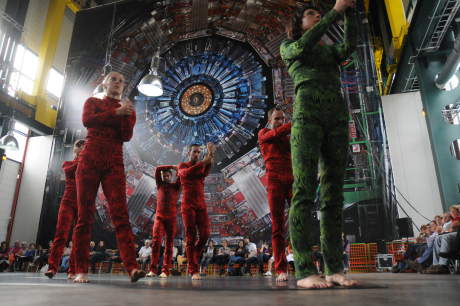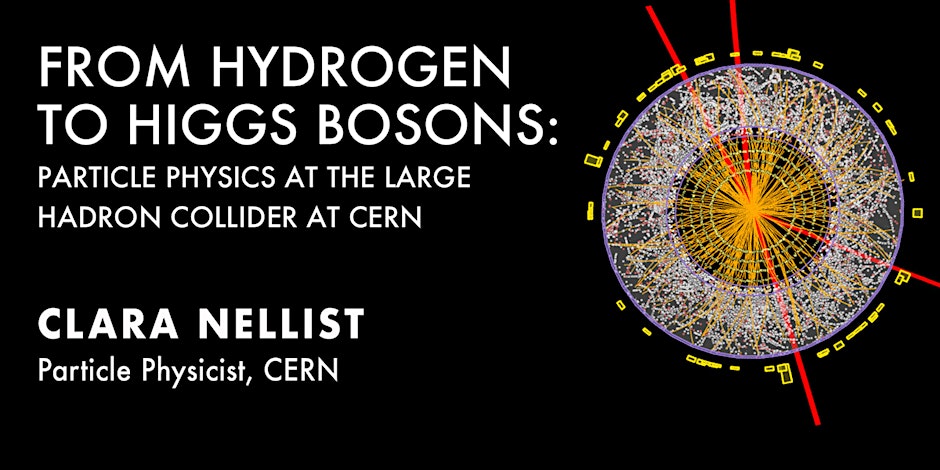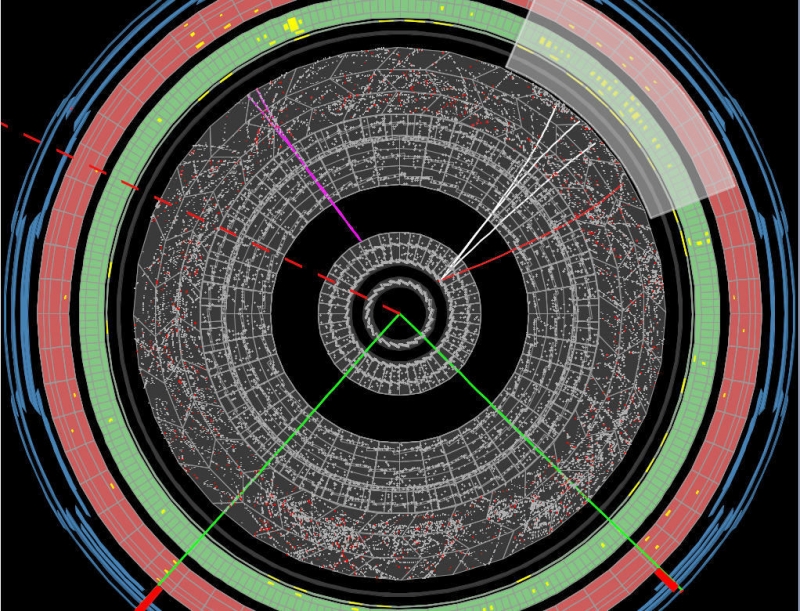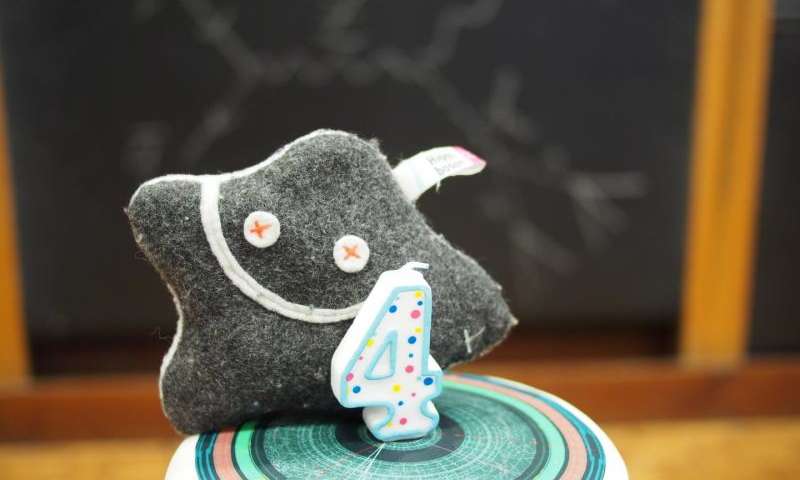Gilles Jobin kindly made time to talk about his arts residency at CERN (European Particle Physics Laboratory) prior to the performances of Quantum (a dance piece resulting from the residency) from Oct. 16 -18, 2014 at Vancouver’s Dance Centre.
Jobin was the first individual to be selected as an artist-in-residence for three months in the CERN/Geneva programme (there is another artist-in-residence programme at the laboratory which is the CERN/Ars Electronica programme). Both these artist-in-residence programmes were announced in the same year, 2011. (You can find out more about the CERN artist-in-residence programmes on the Collide@CERN webpage,
As a main strategy of CERN’s Cultural Policy for Engaging with the Arts, Collide@CERN is a 3-year artist’s residency programme initiated by Arts@CERN in 2011.
By bringing world-class artists and scientists together in a free exchange of ideas, the Collide@CERN residency programme explores elements even more elusive than the Higgs boson: human ingenuity, creativity and imagination.
See below for more information about the Collide@CERN artist residency programmes:
Collide@CERN Geneva Residency
Prix Ars Electronica Collide@CERN Residency
The Collide@CERN prize – an open call to artists working in different art forms to win a fully funded residency – will be awarded annually in two strands (Collide@CERN Geneva and Prix Ars Electronica Collide@CERN) until 2013. It comprises prize money and a residency grant for up to 3 months at CERN.
The winning artists will interact and engage with CERN scientists in order to take their artistic work to new creative dimensions.
The awards are made following two annual international open calls and the jury comprises the cultural partners as well as representatives from Arts@CERN, including scientists.
Planned engagement with artists at CERN is a relatively new concept according to an August 4, 2011 CERN press release,
Today CERN1 launches its cultural policy for engaging with the arts. Called ‘Great Arts for Great Science’, this new cultural policy has a central strategy – a selection process for arts engagement at the level of one of the world’s leading research organizations.
“This puts CERN’s engagement with the arts on a similar level as the excellence of its science,” said Ariane Koek, CERN’s cultural specialist.
CERN’s newly appointed Cultural Board for the Arts will be the advisers and guardians of quality. It is made up of renowned cultural leaders in the arts from CERN’s host-state countries: Beatrix Ruf, Director of the Kunsthalle Zurich; Serge Dorny, Director General of the Lyon Opera House; Franck Madlener, Director of the music institute IRCAM in Paris. Geneva and CERN are represented by Christoph Bollman of ArtbyGenève and Michael Doser, an antimatter scientist. Membership of the board is an honorary position that will change every three years.
The Cultural Board will select one or two art projects a year to receive a CERN letter of approval, enabling these projects to seek external funding for their particle-physics inspired work. This will also build up an international portfolio of CERN-inspired work over the years to come, in conjunction with the Collide@CERN (link sends e-mail) Artists Residency Programme, details of which will be announced in the coming month.
To date, Jobin is the only choreographer to become, so to speak, a member of the CERN community. It was a position that was treated like a job. Jobin went to his office at CERN every day for three months to research particle physics. He had two science advisors, Nicholas Chanon and Michael Doser to help him gain an understanding of the physics being studied in the facility. Here’s Jobin describing his first experiences at CERN (from Jobin’s Collide Nov. 13, 2012 posting),
When I first arrived at Cern, I was captivated by the place and overwhelmed by the hugeness of the subject: Partical [sic] physics… And I had some serious catch up to do… Impressed by the two introduction days in which I had the opportunity to meet many different scientists, Ariane Koeck told me “not to panic” and “to spend my first month following my instinct and not my head…”. …
…
I found out about the 4 fundamental forces and the fact that gravity was the weakest of all the forces. For a contemporary dancer formed basically around the question of gravity and “groundness” that came as a total shock! I was not a “pile of stuff”, but particles bound together by the strong force and “floating” on the surface of the earth… Me, the earth, you readers, the LHC flying at incredible speed through space, without any of us, (including the physicists!) noticing anything… Stardust flying into space… I was baffled…
…
Jobin was required deliver two public lectures, one at the beginning of his residency and the other at the end, as well as, a series of ‘interventions’. He instituted four ‘interventions’, one each in CERN’s library, data centre, anti-matter hall, and cafeteria. Here’s an image and a description of what Jobin was attempting with his library intervention (from his Nov. 13, 2012 posting),

CERN library dance intervention Credit: Gilles Jobin
My idea was to “melt” our bodies into the timeline of the library. Like time chameleons, we were to adapt our movements and presence to the quiet and studious atmosphere of the library and be practically unnoticed. My postulate was to imagine that the perception of time is relative; there was a special texture to “time” inside the library. How long is an afternoon in a library? Never ending or passing by too quickly? It is a shared space, with the unique density you can feel in studious atmosphere and its user’s different virtual timelines. We melted into the element of the library and as we guessed, our “unusual” presence and actions did not create conflicts with our surroundings and the students at work. It was a bit like entering slowly into water and becoming part of the element without disturbing its balance. The time hypothesis worked… I wanted to do more site specific interventions in Cern because I was learning things differently. Some understanding was going through my body. Being in action into the labs…
It was only after the residency was completed that he started work on Quantum (producing a dance piece was not a requirement of the residency). After the residency, he did bring his science advisors, Chanon and Doser to his studio and brought his studio to CERN. Jobin managed to get rehearsal time in one of the halls that is 100 metres directly above the large hadron collider (LHC) during the time period when scientists were working to confirm the existence of the Higgs Boson). There were a number of announcements ‘confirming’ the Higgs. They started in July 2012 and continued, as scientists refined their tests, to March 2013 (Wikipedia entry) when a definitive statement was issued. The definitive statement was recently followed with more confirmation as a June, 25, 2014 article by Amir Aczel for Discover declares Confirmed: That Was Definitely the Higgs Boson Found at LHC [large hadron collider].
As scientists continue to check and doublecheck, Jobin presented Quantum in October 2013 for the first time in public, fittingly, at CERN (from Jobin’s Oct. 3, 2013 blog posting),

QUANTUM @ CERN OPEN DAYS CMS-POINT5-CESSY. Credit: Gilles Jobin
Jobin was greatly influenced by encounters at CERN with Julius von Bismarck who won the 2012 Prix Ars Electronica Collide@CERN Residency and with his science advisors, Dosen and Chanon. Surprisingly, Jobin was also deeply influenced by Richard Feynman (American physicist; 1918 – 1988). “I loved his approach and his humour,” says Jobin while referring to a book Feynman wrote, then adding, “I used Feynman diagrams, learning to draw them for my research and for my choreographic work on Quantum.”
For those unfamiliar with Feynman diagrams, from the Wikipedia entry (Note: Links have been removed),
In theoretical physics, Feynman diagrams are pictorial representations of the mathematical expressions describing the behavior of subatomic particles. The scheme is named for its inventor, American physicist Richard Feynman, and was first introduced in 1948. The interaction of sub-atomic particles can be complex and difficult to understand intuitively, and the Feynman diagrams allow for a simple visualization of what would otherwise be a rather arcane and abstract formula.
There’s also an engaging Feb. 14, 2010 post by Flip Tanedo on Quantum Diaries with this title, Let’s draw Feynman diagrams! and there’s this paper, by David Kaiser on the Massachusetts Institute of Technology website, Physics and Feynman’s Diagrams; In the hands of a postwar generation, a tool intended to lead quantum electrodynamics out of a decades-long morass helped transform physics. In the spirit of Richard Feynman, both the Tanedo post and Kaiser paper are quite readable. Also, here’s an example (simplified) of what a diagram (from the Quantum Diaries website) can look like,
![[downloaded from http://www.quantumdiaries.org/2010/02/14/lets-draw-feynman-diagams/]](http://www.frogheart.ca/wp-content/uploads/2014/10/Feynman-diagram-300x254.png)
[downloaded from http://www.quantumdiaries.org/2010/02/14/lets-draw-feynman-diagams/]
Getting back to Quantum (dance), Jobin describes this choreography as a type of collaboration where the dancers have responsibility for the overall look and feel of the piece. (For more details, Jobin describes his ‘momement generators’ in the radio interview embedded in
part 1 of this piece on Quantum.)
In common with most contemporary dance pieces, there is no narrative structure or narrative element to the piece although Jobin does note that there is one bit that could be described as a ‘Higgs moment’ where a dancer is held still by his or her feet, signifying the Higgs boson giving mass to the universe.
As to why Vancouver, Canada is being treated to a performance of Quantum, Jobin has this to say, “When I knew the company was traveling to New York City and then San Francisco, I contacted my friend and colleague, Mirna Zagar, who I met at a Croatian Dance Week Festival that she founded and produces every year.” She’s also the executive director for Vancouver’s Dance Centre. “After that it was easy.”
Performances are Oct. 16 – 18, 2014 at 8 pm with a Post-show artist talkback on October 17, 2014.
Compagnie Gilles Jobin
$30/$22 students, seniors, CADA members/$20 Dance Centre members
Buy tickets online or call Tickets Tonight: 604.684.2787 (service charges apply to telephone bookings)
You can find part 1 of this piece about Quantum in my Oct. 15, 2014 posting. which includes a video, a listing of the rest of the 2014 tour stops, a link to an interview featuring Jobin and his science advisor, Michael Doser, on a US radio show, and more.
Finally, company dancers are posting video interviews (the What’s Up project mentioned in part 1) with dancers they meet in the cities where the tour is stopping will be looking for someone or multiple someones in Vancouver. These are random acts of interviewing within the context of the city’s dance community.
Vancouver’s Georgia Straight has featured an Oct. 15, 2014 article by Janet Smith about Jobin and his particle physics inspiration for Quantum.
The Higgs boson on its own has inspired other creativity as noted in my Aug. 1, 2012 posting (Playing and singing the Higgs Boson).
As noted in my Oct. 8, 2013 post, Peter Higgs (UK) after whom the particle was named and François Englert (Belgium) were both awarded the 2013 Nobel Prize in Physics for their contributions to the theory of the Higgs boson and its role in the universe.





![[downloaded from http://www.quantumdiaries.org/2010/02/14/lets-draw-feynman-diagams/]](http://www.frogheart.ca/wp-content/uploads/2014/10/Feynman-diagram-300x254.png)